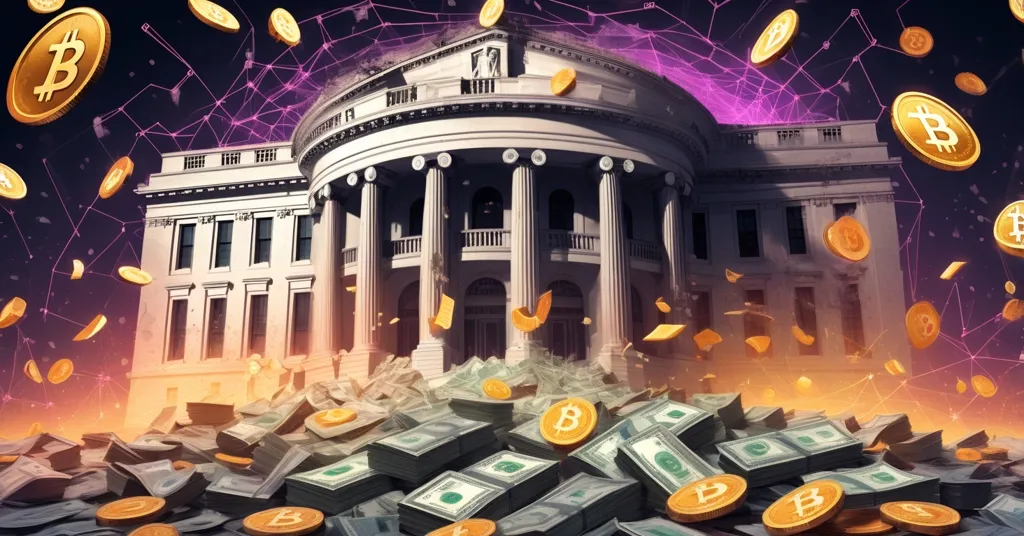U.S. Treasury Slashes Q4 Borrowing to $569B: What It Means for Bitcoin and Crypto Markets

U.S. Treasury Cuts Q4 Borrowing to $569B: Impact on Bitcoin, DeFi, and Crypto Markets
The U.S. Treasury Department has slashed its borrowing estimate for the fourth quarter to $569 billion, a notable reduction from the initial forecast of $590 billion. Driven by a robust cash reserve and stronger-than-expected revenue, this move could have far-reaching implications, not just for traditional markets but for Bitcoin, decentralized finance (DeFi), and the broader cryptocurrency space.
- Borrowing Reduction: Q4 estimate cut from $590B to $569B, with short-term borrowing down to $21B.
- Cash Reserve: Treasury started October with $891B in cash, exceeding prior estimates of $850B.
- Future Plans: Expects to borrow $578B in Q1 2026, targeting a year-end cash balance of $850B.
Treasury’s Fiscal Maneuver: Breaking Down the Numbers
Let’s get straight to the meat of this news. The Treasury’s decision to lower its Q4 borrowing, as detailed in a recent report on the U.S. Treasury’s updated estimates, comes after amassing a cash position of $891 billion at the start of October, a figure that outstripped summer projections by over $40 billion. This hefty buffer, fueled by strong tax inflows and restrained spending, allowed a dramatic cut in short-term borrowing to just $21 billion. For context, short-term borrowing often involves issuing Treasury bills—short-duration debt instruments that mature in weeks or months—used to manage immediate cash flow needs. After the debt ceiling suspension earlier this year forced aggressive issuance to rebuild reserves, this reduction feels like a momentary sigh of relief.
Analysts, as reported by the Financial Times, note that this could ease some strain in bond markets, where a flood of debt supply and rising long-term interest rates have been rattling investors. A more stable Treasury yield curve—essentially the relationship between interest rates and the maturity dates of U.S. government bonds—might reduce volatility in borrowing costs across the economy. It could even make Federal Reserve rate hikes more predictable in the near term. But let’s not kid ourselves: federal spending is still through the roof, dwarfing pre-pandemic levels with no hint of restraint. Entitlement programs, infrastructure initiatives, and other commitments keep the debt engine running full throttle. The Treasury’s plan to borrow another $578 billion in the first quarter of 2026 only confirms that this is a brief pause, not a policy shift. If the U.S. government were a household budget, would you trust it with your savings?
Why Bitcoiners Are Paying Attention
Now, why should anyone in the crypto space care about a bunch of bureaucrats tweaking debt numbers? Simple: the Treasury’s fiscal tightrope act exposes the cracks in centralized, fiat-based systems that Bitcoin was designed to disrupt. For those new to the game, Bitcoin operates on a decentralized network with a fixed supply of 21 million coins, meaning no central authority can inflate it away through printing or borrowing. When government debt levels balloon—and the U.S. national debt is already over $35 trillion according to recent figures—fears of currency devaluation and inflation often follow. Bitcoin, often dubbed “digital gold,” becomes an attractive hedge for investors looking to escape the whims of fiscal mismanagement.
Historically, Bitcoin has seen spikes in interest during times of economic uncertainty tied to government policy. Take 2020-2021, for instance, when massive stimulus packages flooded markets with liquidity—BTC soared past $60,000 as institutional players like MicroStrategy and Tesla piled in, seeking protection against inflation. While this Treasury cut might temporarily calm bond yields, the bigger picture of unchecked deficits keeps those inflation concerns alive. If you’re a Bitcoin maximalist like many of us here, this news is just another brick in the wall of evidence that fiat systems are unsustainable. But let’s pump the brakes on the hype train—Bitcoin isn’t without flaws. Energy consumption debates and scalability issues still dog its adoption, and a stabilized bond market could lure capital back to traditional assets in the short term, potentially cooling BTC’s momentum. Look at past trends: during yield spikes in 2018, Bitcoin struggled as investors flocked to safer bets. Could we see a repeat?
DeFi and Stablecoin Ripple Effects
Beyond Bitcoin, this Treasury update has implications for decentralized finance, or DeFi—financial applications built on blockchains like Ethereum that let users lend, borrow, and save without banks or governments as middlemen. When you see the Treasury juggling billions to manage cash flow, it’s a glaring reminder of the inefficiencies in traditional finance. DeFi protocols like Aave or Compound, which have billions in total value locked (TVL), offer a peer-to-peer alternative that’s looking more appealing by the day. If persistent deficits erode trust in centralized systems, we could see an uptick in users turning to DeFi for financial sovereignty. Ethereum’s smart contracts, which power these platforms, fill a niche Bitcoin doesn’t address, enabling complex financial tools without a central overseer.
That said, DeFi isn’t a silver bullet. High gas fees on Ethereum—transaction costs that can spike during network congestion—and regulatory uncertainty pose real barriers. Plus, let’s not ignore the hacks and exploits that have plagued the space, costing users hundreds of millions. Still, as a counterpoint to fiat’s flaws, DeFi’s potential to disrupt is undeniable. Then there are stablecoins, U.S. dollar-pegged tokens like Tether (USDT) and USD Coin (USDC) that dominate crypto trading and DeFi liquidity. The Treasury’s borrowing adjustments could influence short-term interest rates, which often impact the yields these stablecoins offer in lending protocols or yield farming. If rates stabilize or drop, demand for stablecoins as a high-yield parking spot might shift, affecting liquidity across crypto markets. And with whispers of a U.S. central bank digital currency (CBDC) on the horizon, stablecoins face a regulatory wildcard that could upend their role. Are we ready for that fight?
The Bigger Picture: Challenges and Opportunities
Stepping back, the Treasury’s move to cut borrowing to $569 billion is a small victory for market stability, but it’s like slapping a Band-Aid on a broken dam when deficits keep climbing. For those of us championing decentralization, it’s another data point in the argument for crypto as the future of money. Bitcoin offers a trustless store of value, DeFi reimagines finance without intermediaries, and even altcoins like Solana, with their lightning-fast transactions, carve out roles Bitcoin can’t fill. I lean hard toward Bitcoin maximalism—nothing matches its security and network effect—but I’ll give credit where it’s due: these other innovations are pushing boundaries in their own right.
Yet, we can’t ignore the dark side. Crypto isn’t immune to manipulation, scams, or regulatory overreach. Bitcoin’s price volatility can scare off mainstream adoption, and DeFi’s complexity often alienates newcomers. Hell, even stablecoins, a supposed safe harbor, have had their share of scandals—look at Tether’s murky reserve backing debates. And while I’m all for effective accelerationism, rushing adoption without solving these issues could backfire. On the flip side, every fiscal misstep by centralized powers is a loud advertisement for why we need alternatives. The U.S. debt cycle isn’t going away with one quarterly tweak, and that’s the kind of systemic rot Bitcoin was built to outlast.
Key Takeaways and Questions for Crypto Enthusiasts
- How Does the U.S. Treasury Borrowing Cut Impact Bitcoin as an Inflation Hedge?
While the cut may ease short-term bond market pressures, ongoing deficits and high spending fuel long-term inflation fears. Bitcoin’s fixed supply and decentralized nature position it as a compelling shield against fiat devaluation for wary investors. - Can Fiscal Policies Like This Drive Decentralized Finance (DeFi) Adoption?
Yes, glaring flaws in centralized debt management could push users toward DeFi’s permissionless systems on blockchains like Ethereum. However, barriers like high fees and security risks must be addressed to sustain growth. - What Are the Effects on Stablecoin Markets?
Treasury adjustments might stabilize short-term rates, impacting yields on dollar-pegged stablecoins like USDT and USDC. This could alter liquidity in crypto trading and DeFi, with added uncertainty from potential CBDC competition. - Does This Highlight Systemic Issues Bitcoin Aims to Solve?
Damn right. The reliance on endless borrowing and centralized control underscores the fragility of fiat systems. Bitcoin’s hard cap and trustless design offer a direct counter to such fiscal recklessness, despite its own adoption hurdles.
So, where do we stand? The Treasury’s Q4 borrowing cut is a fleeting reprieve in a saga of ballooning debt and fiscal irresponsibility. For Bitcoin believers, DeFi innovators, and blockchain advocates, it’s a stark reminder of why we’re building alternatives. The old financial guard is creaking under its own weight, and every policy stumble strengthens the case for decentralization. Whether you’re stacking sats, exploring Ethereum’s ecosystem, or just dipping your toes into crypto, the message rings loud: the future of money isn’t just coming—it’s already here, and it’s ours to forge. Will Bitcoin ever fully break free from fiat’s shadow, or are we still tethered to centralized missteps? That’s the question to wrestle with as we watch this space unfold.



